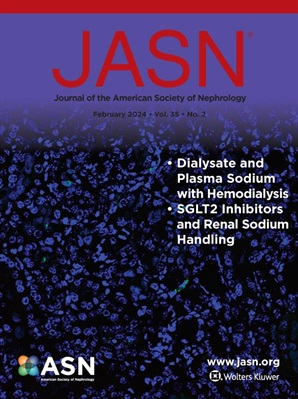Functional Characterization of Anti-C3bBb Autoantibodies and C3 Glomerulopathy Phenotype.
IF 10.3
1区 医学
Q1 UROLOGY & NEPHROLOGY
Journal of The American Society of Nephrology
Pub Date : 2024-09-26
DOI:10.1681/asn.0000000000000499
引用次数: 0
Abstract
BACKGROUND C3 nephritic factors, i.e. autoantibodies that stabilize the C3 convertase of the alternative pathway are the most frequent acquired abnormality in C3 glomerulopathy and primary immunoglobulin-mediated membranoproliferative GN (Ig-MPGN). METHODS Our study included 27 patients with C3 glomerulopathy (n=21) or Ig-MPGN (n=6), of whom 78% were children at disease onset. At the time of sampling, 13/19 (68%) patients with low C3 levels and 8/8 (100%) patients with normal C3 levels were positive for C3 nephritic factors by haemolytic assay. Using novel Luminex assays, we performed a screening for IgG that recognize and affect the formation and/or the stabilization of the alternative pathway C3 convertase (C3bBb). RESULTS Using Luminex assays, an increase in C3bBb formation and/or stabilization was observed in the presence of IgG from 18/27 patients, including 9 with a double-function, 6 only enhancing the C3bBb formation, and 3 that exclusively stabilized C3bBb. All patients presenting a formation and stabilization function had a low C3 level, versus 55% without this double-function. The level of C3bBb formation correlated to the plasmatic C3 but not sC5b-9 levels. The stabilization of C3bBb did not correlate with C3 or sC5b-9 levels. At the last follow-up, 5/27 patients (19%) reached kidney failure after a median delay of 87 [52,119] months. The patients positive for double-function anti-C3bBb antibodies had a 5-year kidney survival of 70% compared to 100% in those negative (P=0.02). CONCLUSIONS Our findings highlight the association of the dual function of C3bBb formation and stabilization with severe C3 consumption and poor kidney survival in C3 glomerulopathy and Ig-MPGN.抗C3bBb自身抗体和C3肾小球病表型的功能特征。
背景C3肾炎因子,即稳定替代途径C3转化酶的自身抗体,是C3肾小球病和原发性免疫球蛋白介导的膜增生性GN(Ig-MPGN)最常见的获得性异常。采样时,13/19(68%)名 C3 水平较低的患者和 8/8(100%)名 C3 水平正常的患者通过溶血检测发现 C3 肾炎因子呈阳性。使用新型 Luminex 检测法,我们筛查了可识别并影响替代途径 C3 转化酶(C3bBb)形成和/或稳定的 IgG。结果使用 Luminex 检测法,观察到 18/27 例患者的 IgG 可增加 C3bBb 的形成和/或稳定,其中 9 例具有双重功能,6 例仅增强 C3bBb 的形成,3 例仅稳定 C3bBb。所有具有形成和稳定功能的患者的 C3 水平都很低,而没有这种双重功能的患者占 55%。C3bBb 的形成水平与血浆 C3 相关,但与 sC5b-9 的水平无关。C3bBb 的稳定与 C3 或 sC5b-9 水平无关。在最后一次随访中,5/27 名患者(19%)在中位延迟 87 [52,119] 个月后出现肾衰竭。结论我们的研究结果突显了 C3 肾小球病和 Ig-MPGN 中 C3bBb 形成和稳定的双重功能与严重的 C3 消耗和肾脏存活率低下之间的关联。
本文章由计算机程序翻译,如有差异,请以英文原文为准。
求助全文
约1分钟内获得全文
求助全文
来源期刊
CiteScore
22.40
自引率
2.90%
发文量
492
审稿时长
3-8 weeks
期刊介绍:
The Journal of the American Society of Nephrology (JASN) stands as the preeminent kidney journal globally, offering an exceptional synthesis of cutting-edge basic research, clinical epidemiology, meta-analysis, and relevant editorial content. Representing a comprehensive resource, JASN encompasses clinical research, editorials distilling key findings, perspectives, and timely reviews.
Editorials are skillfully crafted to elucidate the essential insights of the parent article, while JASN actively encourages the submission of Letters to the Editor discussing recently published articles. The reviews featured in JASN are consistently erudite and comprehensive, providing thorough coverage of respective fields. Since its inception in July 1990, JASN has been a monthly publication.
JASN publishes original research reports and editorial content across a spectrum of basic and clinical science relevant to the broad discipline of nephrology. Topics covered include renal cell biology, developmental biology of the kidney, genetics of kidney disease, cell and transport physiology, hemodynamics and vascular regulation, mechanisms of blood pressure regulation, renal immunology, kidney pathology, pathophysiology of kidney diseases, nephrolithiasis, clinical nephrology (including dialysis and transplantation), and hypertension. Furthermore, articles addressing healthcare policy and care delivery issues relevant to nephrology are warmly welcomed.

 求助内容:
求助内容: 应助结果提醒方式:
应助结果提醒方式:


